

Catálogo en línea. Please Feel the Museum: The Emergence of 3D Printing and Scanning. Liz Neely, USA , Miriam Langer, USA Abstract The September 2012 design issue of Wired magazine features the new Makerbot 3D printer on its cover, with the headline “This Machine will Change the World.”

Will it? The dialogue of participatory and collaborative production must be revisited as new technologies make physical design and construction accessible to the general public. The emergence of a 3D production ecosystem that is broadly accessible both in cost and ease of use makes this technology of particular and immediate interest to museums. Abandoned Suitcases Reveal Private Lives of Insane Asylum Patients. If you were committed to a psychiatric institution, unsure if you’d ever return to the life you knew before, what would you take with you?
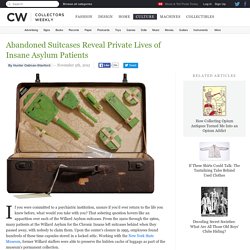
That sobering question hovers like an apparition over each of the Willard Asylum suitcases. From the 1910s through the 1960s, many patients at the Willard Asylum for the Chronic Insane left suitcases behind when they passed away, with nobody to claim them. Upon the center’s closure in 1995, employees found hundreds of these time capsules stored in a locked attic. Working with the New York State Museum, former Willard staffers were able to preserve the hidden cache of luggage as part of the museum’s permanent collection.
“There were many patients in these asylums who were probably not unlike friends you and I have now.” Photographer Jon Crispin has long been drawn to the ghostly remains of abandoned psychiatric institutions. What's a Collection? You'd think we'd know this.

After all we're the Collections Trust. But a collection can be a remarkably tricky thing to pin down. They can be a group of items, or a single item, or (as we learnt some time ago during the Cornucopia project) a house. Museum - Online Collections Home. CAN - Collections Australia Network - Home. Cornucopia. Archaeological Collections in Maryland, Higgins. Introduction The Higgins Site (18AN489) is a multi-component prehistoric site located near the Baltimore-Washington International Airport in Anne Arundel County, Maryland.
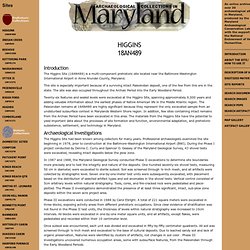
This site is especially important because of a surviving intact Paleoindian deposit, one of the few from this era in the state. The site was also occupied throughout the Archaic Period into the Early Woodland Period. Twenty-six features and sealed levels were excavated at the Higgins Site, spanning approximately 9,000 years and adding valuable information about the earliest phases of Native American life in the Middle Atlantic region.
The Paleoindian remains at 18AN489 are highly significant because they represent the only excavated sample from an undisturbed subsurface context in Marylands Western Shore region. Archaeological Investigations The Higgins Site had been known among collectors for many years. Phase III excavations were conducted in 1988 by Carol Ebright. Artifacts Records References Curry, Dennis C. Documents. Policies, Spurlock Museum, University of Illinois at Urbana-Champaign. National Digital Stewardship Alliance. *New* Recently Published Report: "Geospatial Data Stewardship: Key Online Resources" A report (PDF) of the Geospatial Content Team that lists online resources that highlight key concepts and practices supporting the preservation and stewardship of digital geospatial data and information.

The resources offer a starting point to methods, tools and approaches across the information lifecycle to assist in understanding current best practices in the stewardship of geospatial data. National Park Service - Museum Management Program. NPS Museum Handbook What is the Museum Handbook?

It is a reference guide on how to manage, preserve, document, access and use museum collections. Collections Management « Museum Minute. I was looking through my photos to get inspiration for a different post and I stumbled across this gem.
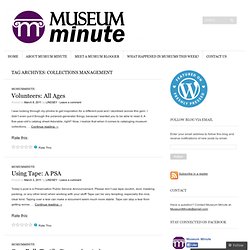
I didn’t even put it through the polaroid-generator thingy, because I wanted you to be able to read it: A five-year-old’s catalog sheet Adorable, right? Now, I realize that when it comes to cataloging museum collections, … Continue reading Today’s post is a Preservation Public Service Announcement. Please don’t use tape (scotch, duct, masking, packing, or any other kind) when working with your stuff! Tape can be very tempting, especially the nice, clear kind.
OKAY. It’s time for another preservation post! Ah, Conserve O Grams, a resource near and dear to my heart. There is nothing better than discovering–or rediscovering–something neat in your collection. In addition to my many other jobs, I also teach preservation classes for the Des Moines Public Schools Community Education Program. Today I want to spend a minute talking about artifact preservation in general. Not collecting dust. The Museum of Northern Arizona has a closet most people could only dream of.
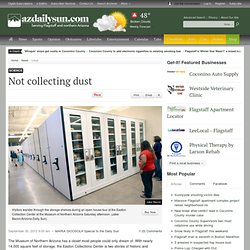
With nearly 14,000 square feet of storage, the Easton Collections Center is two stories of historic and prehistoric possessions, relics and art, all preserved in climate-controlled cabinets. Michael C. Carlos Museum. National Postal Museum Collection Plan. The Sixth Floor Museum. The Museum collects materials related to the assassination of President John F.
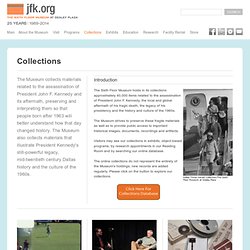
Kennedy and its aftermath, preserving and interpreting them so that people born after 1963 will better understand how that day changed history. The Museum also collects materials that illustrate President Kennedy's still-powerful legacy, mid-twentieth century Dallas history and the culture of the 1960s.